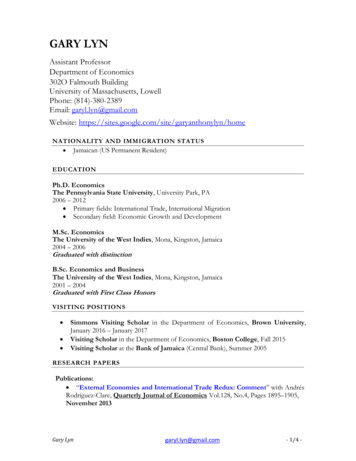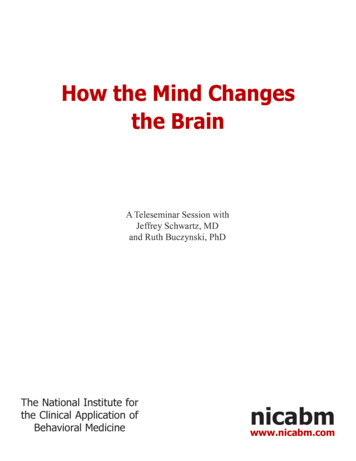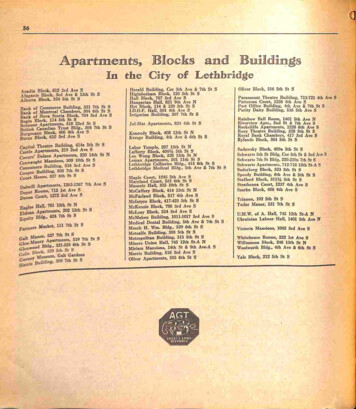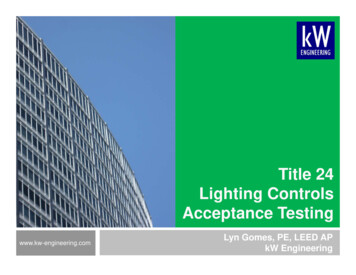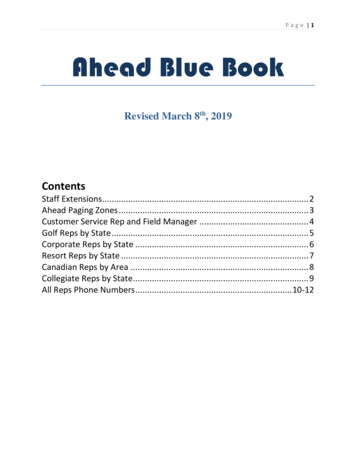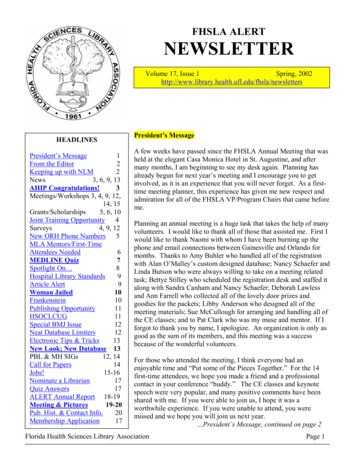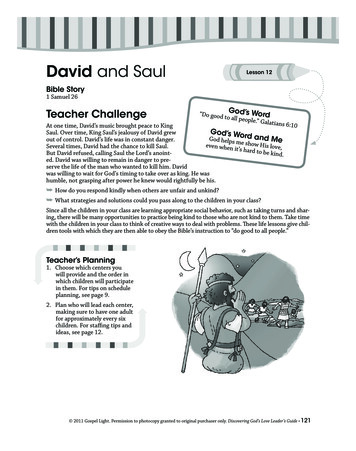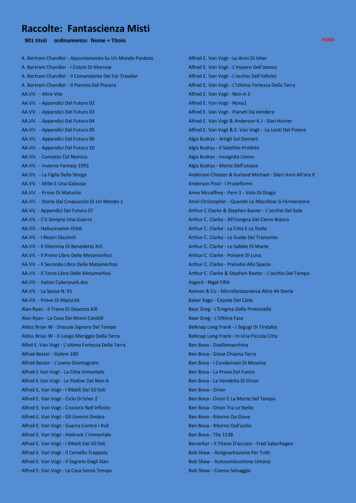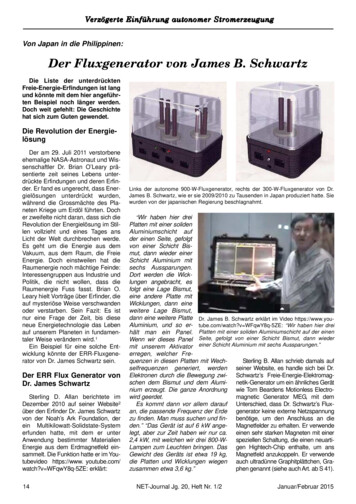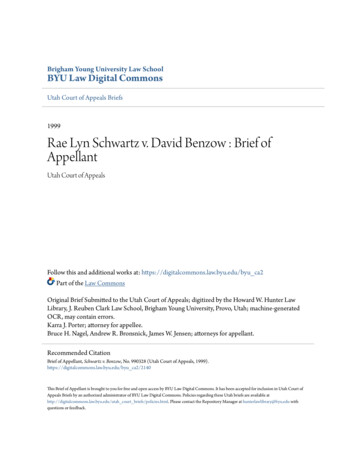
Transcription
Brigham Young University Law SchoolBYU Law Digital CommonsUtah Court of Appeals Briefs1999Rae Lyn Schwartz v. David Benzow : Brief ofAppellantUtah Court of AppealsFollow this and additional works at: https://digitalcommons.law.byu.edu/byu ca2Part of the Law CommonsOriginal Brief Submitted to the Utah Court of Appeals; digitized by the Howard W. Hunter LawLibrary, J. Reuben Clark Law School, Brigham Young University, Provo, Utah; machine-generatedOCR, may contain errors.Karra J. Porter; attorney for appellee.Bruce H. Nagel, Andrew R. Bronsnick, James W. Jensen; attorneys for appellant.Recommended CitationBrief of Appellant, Schwartz v. Benzow, No. 990328 (Utah Court of Appeals, 1999).https://digitalcommons.law.byu.edu/byu ca2/2140This Brief of Appellant is brought to you for free and open access by BYU Law Digital Commons. It has been accepted for inclusion in Utah Court ofAppeals Briefs by an authorized administrator of BYU Law Digital Commons. Policies regarding these Utah briefs are available athttp://digitalcommons.law.byu.edu/utah court briefs/policies.html. Please contact the Repository Manager at hunterlawlibrary@byu.edu withquestions or feedback.
IN THE UTAH COURT OF APPEALSCASE NO.990328-CARAE LYN .vs.DAVID BENZOW,ON APPEAL FROM THE FIFTH JUDICIAL DISTRICTIN AND FOR IRON COUNTYBRIEF ON BEHALF OF PLAINTIFF-APPELLANTRAE LYN SCHWARTZSUBJECT TO PRIORITY UNDER RULE 29(b)(15)Karra J. PorterAttorney for Defendant Appelle David BenzowBruce H. NagelAndrew R. BronsnickJames W. JensenAttorneys for PlaintiffAppellant Rae Lyn SchwartzSEP 11,mCOURT OF APPEALS
CERTIFICATION OF SERVICEI certify that on the date set forth below, I forwarded, viaFederal Express, an original and seven (7) copies of PlaintiffAppellant's Brief:Utah Court of Appeals450 South State StreetSalt Lake City, Utah 84114-0230Attn: Deputy ClefkTwo copies of same was also forwarded, via Federal Express, to:Karra J. Porter, Esq.Christensen & Jensen, PC50 South MainSuite 1500Salt Lake City, Utah 84144I certify that the foregoing statements made by me are true.I am aware that if any of the foregoing statements made by me arewilfully false, I am subject to punishment.ANDREW R. BRONSNICKDATED: September 14, 1999
TABLE OF CONTENTSSTATEMENT ujfJ.J.AW'I.i"RTS DICTIONSTATEMENT OF ISSUESI.Whether the Trial Court irred byDenying Plaintiff's Motion for a NewTrial Based on the Jury's Inconsistentand Completely Incomprehensible Answersto the Special Interrogatories . . . . ,II,Whether the Trial Court Eiieu into Evidence Hearsay StatementsThrough the Testimony of a Police Offxcexl-VieWhere No ExceptionAnirsainnIII, Whether the Trial .'ouxr Erred by Faa.la.ng uoInstruct the Jury That Passing on a SingleLane Road with a Double Yellow Line Is aViolation of Utah Law,STATEMENT '' HK CAPESTATEMENT OF FACTSSUMMARY OF ARGUMENTSARGUMENTPOIN"PLAINTIFF'S MOTION FOR A NEW TRIALSHOULD HAVE BEEN GRANTED BASED UPONTHE INCOMPREHENSIBLE JURY VERDICT .POINT .THE HEARSAY STATEMENT OF .- - a . WOLFEAND CAROLYN SHOULD NOT HAVE BEEN ADMITTEDAT THE TRIALPOINT IIITHE TRIAL COURT FAILED TO PROPERLYINSTRUCT THE JURY REGARDING NO PASSINGZONES UNDER UTAH LAW.CONCLUSIONi
TABLE OF AUTHORITIESBennion v. LeGrand Johnson Construction Company,701 P. 2d 1078 (Utah 1985)10Chi Ids v. Gonda, 972 P. 2d 425 (Utah 1998)17First Security Bank of Utah Nat. A. v. Ezra C.Lundahl, Inc., 454 P. 2d 886 (Utah 1969)Moore v. Burton Lumber and Hardware Co ,631 P. 2d 865 (Utah 1981)State v. Pena, 869 P. 2d 932, 936(Utah 1994)10102,3Van Cleve v. Betts, 559 P. 2d 1006, 1012(Ct. App. Wash. 1977)10Walters v. Querrv, 626 P. 2d 455 (Utah 1991)16Rule 592Utah Code Ann. § 41-6-5916, 17Utah Code Ann. § 78-2-2(3) and (4)Utah Rule of Evidence 80312, 14ii
STATEMENT OF APPELLANT JURISDICTIONThe Court of Appeals has jurisdiction in this matter pursuantto § 78-2-2(3) and (4) Utah Code Ann. 1996, as amended.1
STATEMENT OF ISSUESI.Whether the Trial Court Erred by Denying Plaintiff#sMotion for a New Trial Based on the Jury's Inconsistentand Completely Incomprehensible Answers to the SpecialInterrogatoriesStandard of Appellate Review: the Appellate Court reviews atrial court'sconclusions of law for correctness, granting nodeference to the trial judge's legal determinations.State v.Pena, 869 P. 2d 932, 936 (Utah 1994).The judgment on jury verdict was entered by the Court z("Schwartz") filed a Motion for a New Trial on January 25, 1999.R. 273-74.Thisissue was preservedinthetrialcourt bySchwartz's timely filing of a motion for a new trial.II.Whether the Trial Court Erred by Allowing into EvidenceHearsay Statements Through the Testimony of a PoliceOfficer Where No Exception to the Hearsay Rule AppliedStandard of Appellate review: the Appellate Court reviews atrial court's conclusionsof law for correctness, granting nodeference to the trial judge's legal determination.State v.Pena, 869 P. 2d 932, 936 (Utah 1994).At the time of trial, counsel for Schwartz objected to thestatement of Erica B. Wolfe and Carolyn" as hearsay.exceptionto the hearsayrule was providedbyNo viablethe defendant-appellee, David Benzow pursuant to the Utah Rules of Evidence.(Transcript "T." 251:16-25).2
III. Whether the Trial Court Erred by Failing to Instruct theJury That Passing on a Single Lane Road with a DoubleYellow Line Is a Violation of Utah LawStandard of Appellate Review: the Appellate Courts review atrial court's conclusions of law for correctness, granting nodeference to the trial judge's legal determination.State v.Pena, 869 P. 2d 932, 936 (Utah 1994).During the time of trial, counsel for Schwartz requested ajury instruction that passing is prohibited on a single lane roadwith a double yellow line.The trial court judge did not permitSchwartz's proposed jury instruction.3(T. 313:1-16).
STATEMENT OF THE CASEThisactionwasSchwartz wartz was riding her bicycle on or aboutJune 4, 1995 near Cedar City, Utah when she was involved in anaccident with a yellow Jeep Wrangler. R. 2-5.On July 2, 1997Schwartz filed a Complaint in the Fifth Judicial District for theState of Utah against Benzow. R. 2-5.The trial occurred onNovember 18, 1998 and November 19, 1998. R. 319-320.The juryreturned a verdict of no cause of action on November 19, 1998 withglaring inconsistencies. R. 264-267. On January 13, 1999 the trialcourt judge entered Judgment on Jury Verdict. R. 270-272.OnJanuary 26, 1999 Schwartz filed a Motion for a New Trial. R. 272274.On March 11, 1999 Judge Robert T. Braithwaite entered anOrder denying Schwartz's Motion for a New Trial. R. 297-299.4
STATEMENT OF FACTSThe driver of the yellow Jeep Wrangler, defendant-appellee,David Benzow ("Benzow") passed Schwartz on her bicycle while onState Road 14, a single lane road in both directions with a doubleyellow line between traffic lanes, T. 224.Schwartz was travelingdown hill at approximately 20 to 25 miles'" per hour. T. 113-114.Benzowadmits he passedSchwartzand the groupof bicyclistsaccompanying her immediately prior to the accident. T. 216-218.Schwartz testified at trial that Benzow slowed down as he passedher bicycle and bumped her handlebars, causing Schwartz to lose herbalance and fall. T. 117.As a result of the accident, Schwartzsuffered multiple abrasions to her face, legs and arms, includingpermanent scars and sustained severe damage to her teeth. T. 123126.The basis of Schwartz's motion for a new trial was the blatantinconsistenciesin the verdictNovember 19, 1998. R. 275-278.sheetreturned bythejury onThe jury found that Benzow was notnegligent in the accident involving Schwartz.However, the juryfound Benzow was a proximate cause or contributing proximate causeto Schwartz's injuries. Next, the jury found that Schwartz was notnegligent; however, the jury found that Schwartz was a proximatecause of her own injuries.neitherpartywasLastly, despite the findings thatnegligent,thejury,inansweringjuryinterrogatory #5, attributed negligence to both Schwartz and Benzowin the amount of 50% each. R. 264-267.In addition, during the trial, a police officer testified5
abouthearsayaccident. ssestotheobjectedtotheSchwartzofficer's testimony and no applicable exception to the hearsay rulewas provided. T. 252-253.Nonetheless, the trial judge permittedthe testimony. T. 252. The Court's ruling was critical because thehearsaystatementsofthe witnessesweretheonlypurportedevidence from non-parties which supported the ajuryinstruction stating that passing on a single lane road with adouble yellow line is a violation of Utah law. T. 311-313.Thejudge refused to give this instruction to the jury. T. 313.Schwartz presents the three above issues for review on appeal.6
SUMMARY OF ARGUMENTSThe special verdict form returned by the jury was confusingand incomprehensible.The answers to the special interrogatorieswere inconsistent and did not provide a determination that could beread with any certainty.In particular, the juryfound thatneither party was negligent, but both parties proximately causedthe accident.partyFurthermore, on the one hand the jury found %negligence to both parties.Based upon the jury's obvious inconsistencies, Schwartz movedfor a new trial on the grounds that the verdict was defective.Thetrial judge's denial of Schwartz's motion should be reversed and anew trial granted.During the trial, Benzow called Officer Bigler to the stand asa witness.Officer Bigler testified about his conversations withtwo alleged witnesses to the accident.constitutedhearsaywithoutanyThe officer's testimonyexception.Despiteseveralobjections by Schwartz's counsel, the trial judge permitted thetestimony.Based upon the erroneous introduction into evidence ofthe officer's statements, Schwartz is entitled to a new trial.Finally, Benzow testified that immediately prior to passingMs. Schwartz on her bicycle, he crossed the double yellow line.During the trial, counsel for Schwartz requested that the jury beinstructed with respectto no passingzones. The trialrefused to provide such an instruction.instructthejurywithrespecttotheThe court's failure torelevanterroneous and Schwartz is entitled to a new trial.7judgestatutewas
ARGUMENTPOINT IPLAINTIFF'S MOTION FOR A NEW TRIAL SHOULD HAVE BEENGRANTED BASED UPON THE INCOMPREHENSIBLE JURY VERDICTThe trial court erred in denying Schwartz's Motion for a NewTrial.Plaintiff's motion for a new trial was based upon the factthat the completed special verdict form returned by the jury wasconfusing, nonsensical and incomprehensible.R. 273-278.Theanswers given by the jury were completely inconsistent as it firstfound Benzow was not negligent, but then determined he was 50%negligent.The jury then found Schwartz was not negligent, butlater determined she was 50% negligent.R. 264-267.The juryverdict form could not be read with any certainty or clarity.Schwartz presented this argument before the trial judge, who deniedher motion for a new trial.R. 297-299.Specifically, the jury verdict form was answered as follows:1.Considering all of the evidence in this case, doyou find from a preponderance of the evidence thatthe defendant David Benzow was negligent?ANSWER:No.2.Considering all the evidence in this case, do youfind from a preponderance of the evidence that thenegligence of the defendant David Benzow was e cause of plaintiff's injuries?ANSWER:Yes.8
3.Considering all of the evidence in this case, doyoufindfrom a preponderanceofevidencethatplaintiff was negligent?ANSWER:No.4.Considering all of the evidence in this case, doyou find from a preponderance of the evidence thatthe negligence of plaintiff Rae Lyn Schwartz waseither the sole proximate cause or a contributingproximate cause of plaintiff's erorbothquestion 2 and/or 4 then, and only then, answer thefollowing question:Assumingthecombinednegligenceoftheparties to total 100%, what percentage of thatnegligence is attributable to:a)David Benzow50%b)Rae Lyn Schwartz50%Total:100%See Addendum and R. 264-267.It is readilyapparentfrom the jury'sresponsesto thespecial interrogatories that the jury verdict does not make sense.While the jury did not find either party negligent, they assessed50% negligence to both parties. Additionally, while the jury foundneitherpartywasnegligenttheyproximately caused the accident.alsofoundbothpartiesThese are inconsistent responsesrequiring a new trial.9
Where a case is submitted to a jury on special verdicts, thetrial court should grant a new trial when the jury verdict isincomprehensible and makes no sense.See, Moore v. Burton Lumberand Hardware Co., 631 P. 2d 865 (Utah 1981);see also. Van CIevev. Betts, 559 P. 2d 1006, 1012 (Ct. App. Wash. 1977).Ajury's answersharmoniously.obviousto specialinterrogatories must be readClearly, the jury verdict in this case containsinconsistencies,confirmsjurorconfusion and cannot be read harmoniously.misunderstandingandSchwartz is entitled toa new trial.Normally, a party is not permitted to move for a new trial ongroundsthatthe verdict wasdefective,ifitfailsappropriate action before discharge of the jury.totakeHowever, thisrule does not apply when the verdict is so ambiguous, contradictoryand illogicalverdictthat it does not clearlyis renderedindicateand the verdict willfor whom theleave the court andcounsel in a position of having no alternative but to guess at whatthejuryintended.Bennionv.LeQrandCompany, 701 P. 2d 1078 (Utah 1985).JohnsonConstructionHere, although counsel forSchwartz did not raise an objection at the conclusion of the trial,one is not necessary where the form is incomprehensible.In fact,counsel for Schwartz was not provided a copy of the completed juryform until afterthe jury was discharged.The onlyrecourseprovided to Schwartz was to file a motion for new trial, which wasdone on a timely basis.The trial court erred in not granting Schwartz's motion for anew trial.Judge Braithwaite's Order of March 11, 1999 denying10
Schwartz a new trial should be reversed and Schwartz should begranted a new trial.11
POINT IITHE HEARSAY STATEMENT OF ERICA B. WOLFE ANDCAROLYN SHOULD NOT HAVE BEEN ADMITTED AT THE TRIALErica B. Wolfe was riding her bicycle immediately behind RaeLyn Schwartz, just prior to the accident.unknown) was also a fellow bicyclist.Carolyn(last nameMs. Wolfe and Carolyn wereallegedly witnesses to the accident involving Schwartz and gtheaccident, Jeffrey Bigler, interviewed Ms. Wolfe and Carolyn hoursafter the incident at the hospital.Officer Bigler was a witness for the defense and was preparedto testify at trial regarding his conversations with Ms. Wolfe andCarolyn.The officer was going to provide testimony based on, andin connection with, his police report.Specifically, the officerwas going to testify that Ms. Wolfe told him that: 1. Ms. Wolfe wasriding approximately twelve feet behind and one foot to the rightofSchwartz;2. Ms. WolfedoesnotrememberaJeeppassingSchwartz; and 3. Ms. Wolfe remembered that Schwartz went down onthe road and Ms. Wolfe ran into her.He was going to testify thatCarolyn told him that the defendant's Jeep was not near plaintiffwhen she fell.Prior to the presentation of Benzow's case in chief, counselfor Schwartz objected to Officer Bigler's testimony regardingMs. Wolfe and Carolyn.T. 192:19-25.'Specifically, James W.Jensen, counsel for Schwartz, argued in his in limine motion thatOfficer Bigler should not be permitted to testify about Ms. Wolfe'sand Carolyn's statements because they were inadmissible hearsay.12
T. 192:24-25.The Court denied the motion as premature. T. 198:4-11.Thereafter, defendant called Officer Bigler to the stand andasked him about his conversation with Ms. Wolfe:Q.And did Ms. Wolfe describe the accident foryou?A.Yes. She did.Q.What did she tell you about the accident?MR. JENSEN:Objection, Your Honor. Hearsay. T. 251:10-14.William Stegall, counsel for Benzow responded to the objectionas follows:Yes, your Honor. First I think that thisinformation was gathered by Trooper Bigler inthe course of his investigation being done aspart of his duties with the Utah HighwayPatrol trooper that I believe is admissibleunder 802 -- 803-8.Additionally, it would be a statement made byan individual at or shortly after the eventwhich transpired, and therefore would beadmissibleunderthehearsayexceptionregarding statements made at or near the timeof the event recorded. T.251:21-25.Counsel for Schwartz responded that the exceptions cited to byMr. Stegall were inapplicable to this case and referred the courtto the prior in limine motion.T. 252:2-5.Despite Mr. Jensen'sobjection, the trial judge permitted Officer Bigler to testify tothe hearsay statement of Ms. Wolfe and Carblyn.T. 252:16-25. Thesole basis for the court's decision was: "Okay. He's just askingthe one question. I'mgoing to allow that question. He's notoffering --." T. 252:11-12. No explanation or analysis was given by13
the Court.To compound the error, while the trial court statedthat only one question would be allowed,defensecounsel waspermitted to ask numerous questions which elicited damaging hearsaystatements from the officer.WolfetoldhimshewasOfficer Bigler testified that Ms.abouttwelvefeetbehindSchwartzimmediately prior to the accident; she did not remember a Jeeppassing Schwartz; and Schwartz just went down and Ms. Wolfe raninto her.T. 252:19-25 and 253:10-13.Pointedly, the officer was allowed to testify that anotherbiker -- Carolyn -- told him at the hospital, hours after theaccident, that she did not see the Jeep hit Schwartz as the Jeepwas approximately 15 feet ahead of Schwartz when Schwartz wentdown. T. 253:14 to 254:3.The trial court erred by allowing Officer Bigler to testify tothe hearsaystatements of Ms. Wolfe and Carolyn.First, theexceptions relied upon by defendant are not applicable.of Evidence 803(8) has nothing to do with this case.Utah RuleSee Addendum.The Rule relates to admission of records and recorded statements.Here, defendant did not seek to admit Officer Bigler's policereport,rather, defendanttestifyto out o alleged witnesses.Second, Utah Rule of Evidence 803(8) (C) is also not applicable. SeeAddendum.Again, that rule relates to admissibility of records.Here, records are not the issue.Finally, Officer Bigler spoke toMs. Wolfe and Carolyn at the hospital hours after the accident.The witness statements were not contemporaneous to the accident andlack credibility.14
Our case presents classic hearsay without an deniedBytheopportunity to cross examine Ms. Wolfe and Carolyn and attack,among other things, the reliability of the statements. Compoundingthe situation is that the hearsay statements of Ms. Wolfe andCarolyn were the only evidence" introduced at trial from a nonparty witness to the accident. The statements were the linchpin todefendant's defense.As a result of the foregoing, Schwartz isentitled to a new trial.15
POINT IIITHE TRIAL COURT FAILED TO PROPERLY INSTRUCTTHE JURY REGARDING NO PASSINGZONES UNDER UTAH LAWDuring the trial, defendant Benzow testified that he passedSchwartz, a bicyclist, by traveling onto the other side of the roadcrossing the double yellow line.T. 224:9"-13.As a result, counsel for Schwartz requested a jury instructionwhich was labeled as plaintiff's instruction #22. R. 185-195. Theproposed jury instruction cited directly from Utah Code Ann. § 416-59,regardingno passingzones.Specifically,counselforSchwartz requested that subsection 2 of § 41-6-59 be used.T.311:6-24.where signs or markers are in place to definea no passing zone under subsection 1, anoperator may not drive on the left side of theroad in a no passing zone or on the left sideof any pavement striping design to mark the nopassing zone throughout its length.Utah Code Ann. § 41-6-59 (2); see Addendum.The double yellow lines constitute a "marker" as used in UtahCode Ann. § 41-6-59(2).See Addendum.Judge Braithwaite refusedto instruct on #22. T. 313:14-16. Counsel for Schwartz objected tothejudge'sdecisioninstruction #22.nottouseplaintiff'sproposedjuryT. 313:20-22.Where there is evidence adduced to support a party's theory ofthe case, it is prejudicial and reversiHle error for the trialcourt to fail to instruct thereon.455(Utah 1981).Walters v. Querry, 626 P. 2dHere, Schwartz's theory was that defendantcrossed the yellow lines and struck Schwartz.16It was critical for
the trial court to instruct the jury as to § 41-6-59. If properlyinstructed/ the jury would have been told that a violation of astatute is an inference of negligence.believedBenzowviolatedthestatute,As a result, if the jurytheycouldhavefounddefendant negligent and returned a verdict for the plaintiffs.ChiIds v. Gonda, 972 P. 2d 425(Utah 1998). The trial court'srefusal to charge the jury as to § 41-6-59 was erroneous andSchwartz is entitled to a new trial.17
CONCLUSIONFor the reasons set forth herein, Schwartz is entitled to anew trial.NAGEL RICE & DREIFUSSAttorneys for Plaintiff-Appellant/Dated: «'''-!/.?5c:wp61data\schwartz\briefapp.uta18
ADDENDUM
rll.Ei)F,F T H DISTRICT COURT' 9 9 f?flH 1 1m i l 3 3William A. Stcgall, 3093KIDMAN & ASSOCIATESAttorneys for Defendant6056 S. Fashion Square Drive, Suite 200Murray, UT 84107801-281-3788IN THE FIFTH JUDICIAL DISTRICT COURTIN AND FOR IRON COUNTYSTATE OF UTAHRAE LYN SCHWARTZ,Plaintiff,ORDER DENYING PLAINTIFF'SMOTION FOR NEW TRIAL OROTHER RELIEFvs.Civil No. 970500338DAVID BENZOW,Robert T. BraithwaiteDefendant.Plaintiffs motion for new trial or other relief dated January 25, 1999, was submittedfor decision on February 22, 1999. The court reviewed plaintiff's motion and supportingmemorandum and defendant's memorandum in opposition thereto. Upon the above andforegoing, and the court being fully advised in the premises and good cause appearing therefor:IT IS HEREBY ORDERED that plaintiffs motion for new trial or other relief is* o
denied.Dated this//day of March, 1999.BY THE COURT:Robert T. BralthwaiteDistrict Judge2029ft
1DEPUTY CLERK'L-EZU W IN THE FIFTH JUDICIAL DISTRICT COURTIN AND FOR IRON COUNTYSTATE OF UTAHSPECIAL VERDICT FORMRAE LYN SCHWARTZ,Civil No. 970500338Plaintiff,Judge Robert T. Braithwaitevs.DAVID BENZOW,Defendant.MEMBERS OF THE JURY:Please answer questions 1 through 6 from a preponderance of the evidence. If you findthe evidence preponderates in favor of the issue presented, answer "Yes." if you find theevidence is so equally balanced that you cannot determine a preponderance of the evidence, orif you find that the evidence preponderates against the issue presented, answer "No". Also,any damages assessed must be proven by a preponderance of the evidence.1.Considering all of the evidence in this case, do you find from a preponderanceof the evidence that defendant David Benzow was negligent?ANSWER:YesNoX
2.Considering all of the evidence in this case, do you find from a preponderanceof tne evidence that the negligence of the defendant David Benzow was either the soleproximate cause or a contributing proximate cause of plaintiff s injuries?ANSWER:3.Yes XNoConsidering all of the evidence in this case, do you find from a preponderanceof the evidence that plaintiff was negligent?ANSWER:4.YesNo y(Considering all of the evidence in this case, do you find from a preponderanceof the evidence that the negligence of plaintiff Rae Lyn Schwartz was either the sole proximatecause or a contributing proximate cause of plaintiff s injuries?ANSWER:5.Yes CNoIf you have answered u Yes" to either or both Questions 2 and/or 4 then, andonly then, answer the following question:Assuming the combined negligence of the parties to total 100%, what percentage of thatnegligence is attributable to:A.David BenzowB.Rae Lynn SchwartzTOTAL:6.fiO%SO%100%If you have answered -u Yes" to Question 2 and you have attributed to defendantDavid Benzow more than 50% ot the total negligence, then, and only then, state the amount of
damages, if any, sustained by plaintiff as a proximate result of plaintiff s injuries. IfQuestion 2 was answered "No/ or if you have attributed to defendant David Benzow 50% orless of the total negligence, then do not answer this question.A.Past Medical Expenses B.Future Medical Expenses C.General Damages(pain and suffering, etc.) TOTAL: PUNITIVE DAMAGESIf you have answered "Yes" to Question 2, and if you have attributed more than 50%of the total negligence to defendant David Benzow, then, and only then, answer question 7.Please answer Question 7 from clear and convincing evidence. If you find the evidencehas reached a point where there remains no substantial doubt as to the truth or correctness ofthe conclusion based on the evidence, answer "Yes." If there is any substantial doubt as to thetruth or correctness of the conclusion based On the evidence, answer "No."7.Do you find by clear and convincing evidence that the acts or omissions ofdefendant were a result of willful and malicious conduct or conduct that manifested a knowing
and reckless indifference toward, and a disregard of, the rights of plaintiff?ANSWER:Dated this) \YesNoday of November, 1998.Foreperson
RULE 803 HEARSAY EXCEPTIONS: AVAILABILITY OF DECLARANT IMMATERIALThe following are not excluded by the hearsay rule, even though thedeclarant is available as a witness:(8) Public Records and Reports.Records, reports, statements, or data compilations r in anyform, or public offices or agencies, setting forth (A)v vtheactivities of the office or agency, or (B) matters observedpursuant to duty imposed by law as to which matters there was aduty to report, excluding, however, in criminal cases mattersobserved by police officers and other law enforcement personnel, or(C) in civil actions and proceedings and against the Government incriminal cases, factual findings resulting from an investigationmade pursuant to authority granted by law, unless the sources stworthiness.
41-6-59. Signs and markings on roadway — No passingzones — Exceptions*(1) (a) The Department of Transportation and local authorities may determine those portions of any highway under their respective jurisdictionswhere overtaking and passing or driving on the left of the roadway isespecially hazardous and may by appropriate signs or markings on thehighway indicate the beginning and end of those zones.(b) When the signs or markings are in place and clearly visible to areasonably observant person, every operator of a vehicle snali ooey thedirections.(2) Where signs or markings are in place to define a no-passing zone underSubsection (i), an operator may not drive on the left side of the roadwaywithin the no-passing zone or on the left side of any pavement striping designed to mark the no-passing zone throughout its lengths.(3) This section does not apply to Subsection 41-5-53(l)(b) nor to the operator of a vehicle turning left onto or from an alley, private road, or driveway.History: L. 1941, ch. 52. 49: C. IS4S,57*7-126; L. 1975, ch. 207. * 17; 197S. ch. 33,§ 13; 1987. ch. 138, i 58.
Bruce H. Nagel, Andrew R. Bronsnick, James W. Jensen; attorneys for appellant. This Brief of Appellant is brought to you for free and open access by BYU Law Digital Commons. It has been accepted for inclusion in Utah Court of Appeals Briefs by an authorized administrator of BYU Law Digital Commons. Policies regarding these Utah briefs are .

![No, David! (David Books [Shannon]) E Book](/img/65/no-20david-20david-20books-20shannon-20e-20book.jpg)
